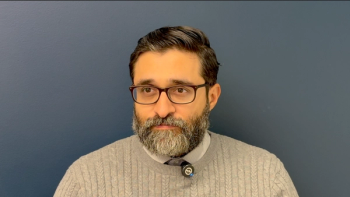
Oncology NEWS International
- Oncology NEWS International Vol 11 No 10
- Volume 11
- Issue 10
Docetaxel/Gemcitabine Effective in Advanced NSCLC
ORLANDO-Weekly docetaxel (Taxotere) combined with gemcitabine (Gemzar) is a useful doublet in circumstances in which a platinum-containing doublet is not desirable in the treatment of advanced non-small-cell lung cancer (NSCLC), according to the ACORN 9901 multicenter trial. Ravindrath Patel, MD, of the Comprehensive Blood and Cancer Institute, Bakersfield, California, presented the data at a poster session of the 38th Annual Meeting of the American Society of Clinical Oncology (abstract 1276).
ORLANDOWeekly docetaxel (Taxotere) combined with gemcitabine (Gemzar) is a useful doublet in circumstances in which a platinum-containing doublet is not desirable in the treatment of advanced non-small-cell lung cancer (NSCLC), according to the ACORN 9901 multicenter trial. Ravindrath Patel, MD, of the Comprehensive Blood and Cancer Institute, Bakersfield, California, presented the data at a poster session of the 38th Annual Meeting of the American Society of Clinical Oncology (abstract 1276).
The results apply to the subpopulation of patients unable to tolerate standard cisplatin (Platinol)-based chemotherapy. In this study, the docetaxel/gemcitabine doublet was compared with paclitaxel (Taxol)/gemcitabine, and offered an improved toxicity profile.
The randomized phase III study included 113 patients with advanced NSCLC, 94 of whom were evaluable. Two thirds of patients had stage IIIB disease, and one third had stage IV; two thirds were performance status (PS) 0-1 and one third were PS2. A greater than 5% weight loss was seen in 27%.
Patients were randomized to receive either docetaxel 40 mg/m2 and gem-citabine 1,200 mg/m2 on days 1 and 8 every 3 weeks or paclitaxel 120 mg/m2 plus gemcitabine 1,200 mg/m2 on days 1 and 8 every 3 weeks. The median number of cycles delivered was three in each treatment arm.
The docetaxel/gemcitabine arm proved more favorable in all response parameters, although the differences did not reach statistical significance. Objective responses were seen in 15 of 43 patients in the docetaxel/gemcitabine arm (30%) and 11 of 45 patients (23%) in the paclitaxel/gemcitabine arm. This included one complete response (2%) with docetaxel/gemcitabine and none in the other treatment arm, Dr. Patel reported.
He noted that more patients in the docetaxel/gemcitabine arm also had stable disease: 16 (32%) vs 12 (27%) with the paclitaxel/gemcitabine combination.
Patients taking paclitaxel had more frequent grade 4 neutropenia and grade 3-4 neurotoxicity. Toxicity grade 2 or greater was also more frequently seen with paclitaxel in terms of diarrhea, anemia, and stomatitis.
The study concluded that for patients in whom non-platinum-based chemotherapy is preferred, docetaxel plus gem-citabine is a good option. This regimen produced a higher response rate, higher percentage of patients with stable disease, and a better toxicity profile than paclitaxel plus gemcitabine because of its lower frequency of neuropathy, anemia, neutropenia, diarrhea, and stomatitis, Dr. Patel concluded.
Articles in this issue
about 23 years ago
FDG-PET Predicts Prognosis in Primary Osteosarcomaabout 23 years ago
Vaccine Turns Immune System Against Cancer Cellsabout 23 years ago
Three Themes to Guide von Eschenbach at NCIabout 23 years ago
Arimidex Approved for Early-Stage Breast Cancer in Postmenopausal Ptsabout 23 years ago
Long-Term Exposure to Diesel Exhaust Poses Lung Cancer Riskabout 23 years ago
Most Americans Unaware of Excessive Weight as a Risk for Some Cancersabout 23 years ago
Three Themes to Guide von Eschenbach as NCI Directorabout 23 years ago
Gleevec Gets FDA Priority Review for First-Line Use in Early CMLabout 23 years ago
New Anti-HIV Agent Prevents Virus From Entering Cellabout 23 years ago
Infusional FUFOX: Better PFS in Advanced Colorectal CancerNewsletter
Stay up to date on recent advances in the multidisciplinary approach to cancer.




















































































